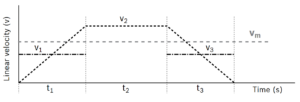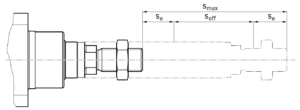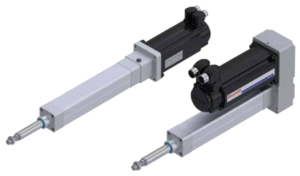The Electromechanical Cylinder Product Catalog (linked here) identifies and suggests four main parameters when considering what configuration of EMC is best suited for a particular application. Those four parameters are the application’s load, dynamics, geometry, and environmental conditions. It is important to completely define the application of the EMC before making a purchasing decision due to its specialized nature.
Load
Various loads surrounding the EMC need to be considered when picking an appropriate configuration:
- The amount of force required for the process
- The mass of the objects being worked on
- The external forces on the EMC itself
- Duty cycle of the EMC
- Servicing requirements for the lifetime of the EMC
Characterizing the way the force changes over the cycle of motion is an important factor when determining the average force over one entire cycle of the piston rod. One warning that Bosch Rexroth gives when defining the application is that large factors of safety relating to the forces required should be avoided to ensure that the internal axis of the EMC is not over-sized. An example graph of required forces over an arbitrary EMC cycle is shown below.

Figure 1: Arbitrary loads as a function of time
Another one of the more important sub-parameters of loads to consider is the duty cycle of the EMC. Duty cycle is the percentage of time where the EMC is active compared to the total time of the cycle. Duty cycle is important to help determine the life expectancy of the EMC, as well as the life expectancy of the individual components. The duty cycle for any operation, relating to an EMC or not, can be calculated using the following equation:

where DC is duty cycle in percent, t_O is operating time in seconds, and t_P is pause time in seconds.
Dynamics
The intended motion of the EMC and piston rod need to be considered when selecting a configuration:
- Acceleration of the rod
- Travel speed of the rod
- Cycle time of the rod
Similarly to the duty cycle, the characteristics of the EMC as a whole over the entire cycle, operating or pausing, need to be considered. The cylinder itself and drive device selected for the application can be better configured to maximize cost efficiency and performance if the entire cycle is defined. An example graph of linear velocity of the EMC as a function of time to describe an entire arbitrary cycle is shown below.

Figure 2: Arbitrary linear velocity as a function of time
Geometry
The geometry of the EMC and how it will fit and interact with the space it is used in needs to be considered when completing a configuration:
- Work space
- Installation space
- Maximum required length of actuation
- Interfering elements
When determining the maximum travel range of the EMC, it is important for the lifespan of the product to not design the EMC to travel to the absolute end of the internal mechanical stop. A travel buffer should be included in the design at both the maximum extension and retraction of the stroke. The effective operating stroke and designed stroke buffer at both ends should total to the maximum stroke when placing the order. A diagram highlighting this suggestion is shown in the figure below.

Figure 3: Maximum stroke as a summation of effective and buffer lengths
Due to the structure of the cylinder, the total length of the EMC is longer than the maximum stroke. This should come as no surprise, as the screw drive nuts and bearings need to be included in the total length. A diagram with an internal view into an EMC is shown in the figure below, with S_max signifying the maximum stroke, L_ZS representing the position of the piston rod when fully retracted, L_ad identifying the length of internal components of the EMC, and L_BC describing the length of the body of the cylinder.

Figure 4: Internal view of EMC
One more decision to make when considering the geometry of the EMC is the positioning of the motor on the end of the cylinder. Two options are available: either mounting the motor colinearly and coupling the motor shaft, or mounting the motor parallel to the axis and using a belt to connect the motor shaft and the Ball Screw Assembly. Both configurations are shown in the picture below, with the colinear option on the left and the parallel option on the right.

Figure 5: Motor mounting options for the EMC
Environmental Conditions
Lastly, another parameter that needs to be considered when configuring the EMC are the environmental and installation conditions that the cylinder will be subject to:
- Installation position
- Mounting options
- Degrees of freedom and motion
- Temperature and humidity
- Contamination and hygiene
- Vibrations
When installing the EMC, the technician should be careful of applying transverse forces and distortive stress on any part of the cylinder. The piston rod especially is susceptible to damage, and any alignment errors can shorten the lifespan of the product. The type of attachment and fastening element for the EMC have an impact on the maximum permissible axial load as well. For more information about loads and fastening elements, please refer to the “Attachments and accessories” section in the EMC Product Catalog linked above.
The environment that the EMC will be functioning in has a deterministic impact on the lifespan of the cylinder. Extreme temperatures, debris, and chemicals can have a serious impact on the seals, lubricant, and overall performance of the motor and screw drive if not serviced properly.
All pictures retrieved from the EMC Product Catalog at https://www.boschrexroth.com/en/us/products/product-groups/linear-motion-technology/topics/linear-motion-systems/electromechanical-cylinder-emc/index





